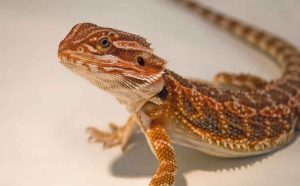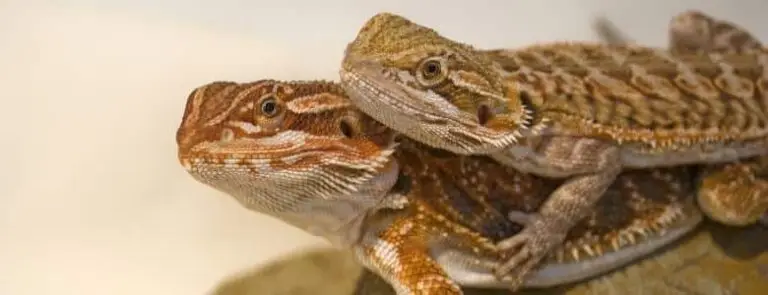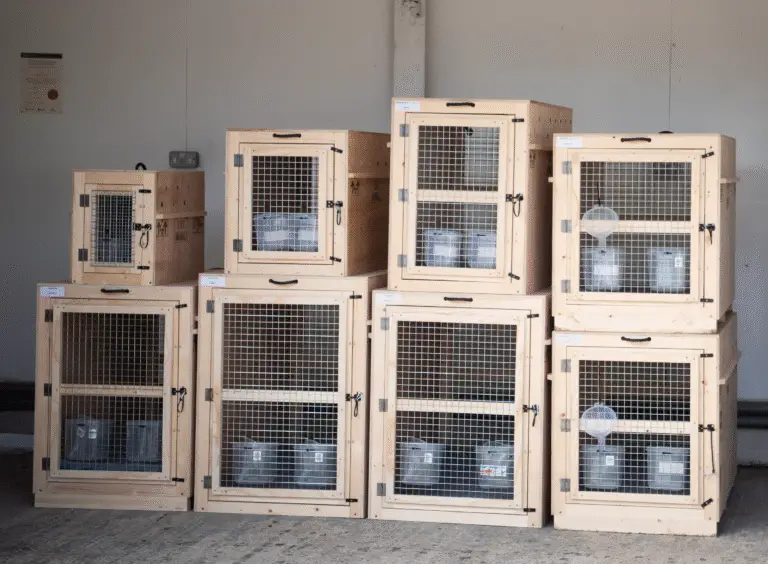A few weeks ago we mentioned that we flew a Bearded Dragon named Cookie to Zurich. With that story being rather interesting, we thought we would share with you a guide to caring for Bearded Dragons.
Many people wonder what it would be like to care for a reptile, but never go through with it because of the belief it may be too complicated. But really it isn’t complicated at all. Bearded dragons are probably the most popular pet lizard and this is not without good reason. They are wonderful pets, and are very friendly too if taken care of properly (don’t worry, they don’t have teeth, so aren’t able to bite you!)
A large majority of Bearded Dragon owners will start with a beardy which may only be a few weeks old. Just like kittens and puppies, it’s nice to start off small and watch your pet grow as it gets older, and with that the pet will learn to trust you from an early age.
In the wild, Bearded Dragons inhabit the semi-arid woodlands and rocky deserts of Central Australia. They are a medium sized lizard, reaching approximately 2ft in length, with about half of that accounted for by the tail. The life expectancy of a bearded dragon tends to be around 10 years, though some have been known to live longer than 15 years! Bearded dragons communicate through visual displays, both for breeding purposes and dominancy determination. These displays may include arm waving, head bobbing and colour changes.
Vivarium: Most new starters are unsure what size vivarium to get for their beardy and that all depends on the size of the dragon. If the beardy is a juvenile and only small, then a vivarium of around 3ft wide by 15” in height may be suitable. However, after around 6/8months the vivarium would require an upgrade as bearded dragons grow quite quickly. If you’re not worried about the price and have the space for a larger vivarium, then you can save a lot of costs in the future by starting bigger, so anything around 4ft/5ft would be suitable.
Heating Sources: This all depends on the size of the vivarium and the size of reptile, but there are many heat lamps available online or in reptile stores. A lot of users stock infra-red and moonlight bulbs which are great for smaller enclosures, but if these are not powerful enough to heat a larger enclosure, then the best option may be to use Ceramic heat bulbs.
The best temperature to have from the heat source is around 84 degrees and the ideal way of keeping the temperature at that level is by using thermostats. Thermostats are genuine lifesavers when it comes to keeping reptiles! They can be used to control heat sources and there is a thermostat suitable for virtually all heat sources, including incandescent and infra-red bulbs, ceramic hearts and bulbs, heat mats and heat strips. Thermostats come in two ranges; either standard or digital. Essentially, both ranges do the job of controlling your heat sources as well as each other, however digital forms offer a bit more with regard to user feedback and programming options.
Heat mats are also suitable for being placed inside a wooden vivarium as a hot-spot and are safe for use with most species. They do not overheat and therefore rarely need to be combined with a mat-stat, unless the heat mat is heating a small enclosure with little ventilation.
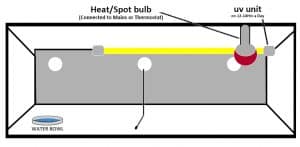
Ultra-Violet Lighting: Bearded dragons need a UV light source which replicates the sun. It is important for them to gain their source of protein, and without it you could find them becoming unhealthy.
It is recommended using the 10-12% tubes and providing the bearded dragons with suitable shaded areas, so that they have the ability to choose the intensity of UV that they require for themselves. Once a UV light has been switched on they have a life expectancy of around 6 months. It is recommended to take note of when you first use the UV light, so you know when to replace it.
Substrate: It is recommended not to use sand with younger dragons, as they can often miss their prey gulping up a mouth full of the stuff. It can get stuck in their stomach and they may not be able to pass it, which could lead to be fatal. The most popular choices would be reasonably larger wood shavings which is safer for the reptiles.
Décor: Caves, hides and other décor are not only for aesthetic purposes, but provide your animals with places to hide away and feel secure. Providing your animal with hides is essential to their well-being and contrary to what you might expect, the more hiding places you provide, the more likely you are to see your animal out and about and behaving naturally!
Cork bark is incredibly versatile; it can be used as hiding places, climbing equipment and decoration. It comes in a range of sizes, so you’ll be able to find something suitable for your vivarium. Bod wood allows you to create a natural and exotic setting for your attractive terrarium. It is a material from trees that have been buried in peat bogs and preserved from decay by the acidic and anaerobic bog conditions, sometimes for hundreds or even thousands of years. Being a natural product, it may contain tannis that will change the colour of any water that it might be sitting in. The tannis are harmless but can be removed by rinsing the wood with boiling water and leaving it to stand in a bucket of water for a week or so.
Plants are also a great way to make an attractive addition to many vivariums, but can serve as more than just aesthetics – they can create good hiding places for smaller lizards. They also come in various styles including flowering bunches and vines to suit a range of needs in your vivarium. A lot of people also use standing plants, which make great decorative items to add that naturalistic touch to your animal’s environment. They are very well decorated and look extremely realistic.
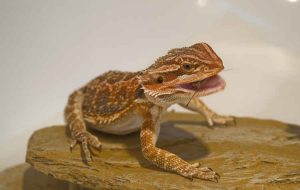
Feeding and Vitamin Supplements:
Many different feeding routines and diets have been used with varying levels of success. Bearded dragons from ten weeks old to one year should be given 3-4 meals a week, divided into roughly 2 meals of vegetable matter and 2 insect meals. These meals should be fed separately to prevent your animal becoming picky with its food. The vegetable part of the diet is made up of 90% leafy greens and 10% fruits and vegetables.
The quantities in the meals will increase as your animal gets older, but the frequency of the meals become less. 2-3 meals a week will be enough for adults, consisting of equal amounts of insects and greens.
Live Foods: They love crickets, which often come in a great quantity from pet shops and should last a long time. Another popular source of food is live meal worms, which are simple and clean and make a delicious high-protein treat. The only thing recommended when using meal worms is not to feed too many in a short space of time to smaller bearded dragons as the shell can be difficult to digest.
Unsafe Foods:
– Do not use vegetables with high water content often, such as Iceberg lettuce and cucumber
– Citrus fruits
– Vegetables with high starch content, such as potatoes
– Tomato seeds or sweetcorn as they are indigestible
– Do not use too much cabbage or any other plants of the Brassica genus (Brussels, broccoli, kale) as they contain large amounts of goitrogens. This has a negative effect on many metabolic processes.
– Do not use too much spinach, strawberries, tomatoes or any other plant that contains large amounts of oxalates.
– Parsley
– Avocado
– Rhubarb
Some Safe Foods:
– Weeds such as dandelions
– Mustard greens
– Endive
– Rocket
– Watercress
– Squash
– Green beans
– Asparagus
Bearded dragons can be picky with their food. Quite often when presented with an abundance of food, they will just eat what they fancy and wait for the next time it becomes available. Be strict!
A good quality vitamin and mineral supplement is essential to the well-being of your animal, always read the packaging carefully. We recommended Nutrobal or Repton on 2 of 3 meals. Failure to maintain a good supply of vitamins and minerals will results in irreversible illness, such as Metabolic Bone Disorder.
